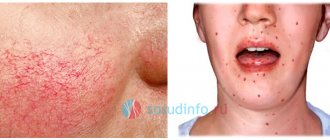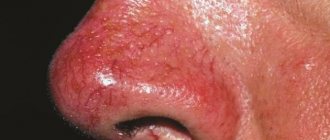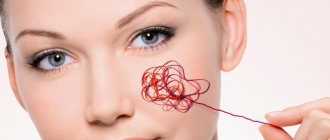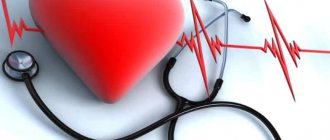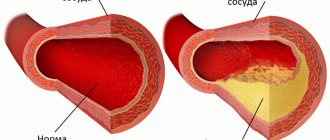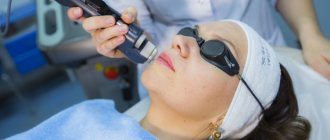Vessels on the face (telangiectasia) are a cosmetic defect in the form of a vascular network or dots (stars), appearing as a result of the expansion of epidermal capillaries and venules. The skin around telangiectasia may have a reddish, reddish-burgundy or bluish tint, so such defects stand out significantly against the background of healthy skin. Single vessels on the face may not cause discomfort, but if there are many telangiectasias or they are large in size, the person begins to feel embarrassed about his face and have difficulty communicating with others.
Most angiosurgeons recommend removing small vessels on the face using surgical methods: sclerotherapy, endovenous coagulation or radiofrequency ablation. Although these methods are highly effective, they are not suitable for everyone, as they require a long recovery period, so doctors and patients often resort to safer methods of treating rosacea, for example, laser removal.
Laser removal of blood vessels on the face
Principles of laser treatment of telangiectasia
Laser therapy is a fairly “young” direction in aesthetic medicine, which began to actively develop and be used for the treatment of skin diseases only in 1970. Despite this, laser treatment has already established itself as one of the most effective methods of combating age-related and stress-related changes, external defects (scars, scars, stretch marks, rosacea, age spots), as well as chronic inflammatory skin diseases.
In dermatology, laser therapy is also used to treat chronic infectious skin diseases (acne, acne, furunculosis) without exacerbation, since the laser flow has a powerful antibacterial effect and provides disinfection in the deep layers of the dermis. Laser light radiation is especially active against coccal flora, representatives of which are the main causative agents of skin infections.
Laser therapy helps get rid of many skin diseases
The use of laser in the treatment of vascular pathologies became possible thanks to the development of a fractional laser thermolysis technique based on fragmentary effects on the tissues of the epidermis and dermis, as well as their components (blood vessels, lymphatic ducts, hair follicles, sebaceous glands, etc.). The beam penetrates the tissues to a given depth, warms them up, as a result of which the excess blood filling the dilated vessels is “evaporated” and the walls of the capillaries stick together.
The therapeutic effect of laser therapy in the treatment of rosacea is due to the following processes occurring in the damaged vessel under the influence of laser light energy:
- absorption of laser radiation by the blood, as a result of which it heats up to 280-300, and steam bubbles form in it;
- thermal damage to the vascular wall (as a result of contact with hot steam bubbles), which causes destruction of the endothelial layer lining the vessels from the inside;
- thickening of proteins in the subendothelial lining of the vessel;
- increased activity of endothelial cells responsible for endothelial regeneration and restoration of normal blood flow;
- the formation of necrotic changes in the vascular wall.
Effect of laser on blood vessels
The meaning of the procedure is to “glue” the vessel and evaporate excess accumulated blood. The result of laser thermolysis ranges from a reduction in size and color intensity to the complete removal of blood vessels on the face.
Electrocoagulation of blood vessels on the legs: contraindications
There are health conditions in which the method of sealing vessels using electric current is undesirable or completely excluded. This means that there is a high risk of the patient's condition worsening and alternative treatments should be sought. Electrocoagulation is not possible if:
- individual intolerance to electric shock treatment;
- allergic reactions to anesthetics;
- blood clotting disorders;
- viral skin lesions, with the appearance of grouped rashes (in active form);
- infectious diseases during exacerbation;
- mental disorders and personality disorders in the stage of decompensation;
- diabetes mellitus in the stage of decompensation;
- the presence of implants in the lower limb;
- presence of a pacemaker;
- oncology at the stage of active therapy.
Who is indicated for laser coagulation of blood vessels?
Laser coagulation of blood vessels (not to be confused with endovasal laser coagulation of veins, which is a medical procedure and is performed strictly in a hospital setting) can be used to treat all manifestations of rosacea, as well as scars and scars remaining on the skin after removal of moles and other neoplasms.
The use of laser on the face is effective in the presence of the following cosmetic skin defects:
- vascular points and asterisks;
- vascular networks consisting of clearly visible small blood vessels (venules, arterioles, capillaries) of red or burgundy color;
- benign tumors formed from endothelial cells lining the surface of blood vessels from the inside (hemangiomas);
- capillary moles (flaming nevi);
- tumors consisting of newly formed blood vessels (angiomas);
- symptoms of rosacea (papules, red spots, telangiectasia, pustules).
Rosacea is one of the indications for laser therapy
The number of procedures required to completely remove blood vessels on the face is selected individually and depends on the number of defects and the time of their appearance. For example, to get rid of fresh hemangiomas, 1 procedure is usually sufficient. For vascular defects, from the moment of appearance of which 1 to 3 years have passed, you will need to undergo 3-4 procedures. The same number of sessions is necessary when working with a large number of dilated vessels (vascular networks).
Note! If necessary, removal of blood vessels on the face can be carried out simultaneously with other cosmetic procedures, for example, laser rejuvenation or fractional resurfacing of scars and scars.
The essence of the procedure
In modern medical practice, there are several types of techniques that allow you to quickly cauterize the vessels in the nose (coagulation, laser correction, vasotomy and much more). The essence of each method comes down to one simple task: eliminating nasal breathing dysfunctions and normalizing vascular function. A similar effect is achieved through the use of various equipment and methods of influencing pathological areas by cauterization. It is the coagulation of the mucous membrane and adjacent blood vessels that helps solve such problems.
The most important thing is the choice of an appropriate technique for coagulation of nasal vessels, which is possible only after a thorough diagnosis of the reasons that caused the development of the deviation. This is due to the fact that cauterization operations can be performed only if the pathology was caused by an enlargement of the nasal turbinates, and not by a deviated septum or mechanical injury
Advantages and disadvantages
An important advantage of fractional laser therapy over surgical methods of vessel removal (including minimally invasive endovasal laser obliteration) is the absence of a difficult rehabilitation period. The patient can do his usual activities and return to work duties the very next day after the procedure, while pain after using the laser is practically absent thanks to the use of modern radial light guides.
Radial light guides are used for laser removal of blood vessels.
Among the positive characteristics of laser coagulation, the following are also particularly significant:
- comfort for the patient (no severe pain during laser operation and during the recovery period);
- low likelihood of side effects and complications if you follow the technique of using the device, proper preparation and compliance with the cosmetologist’s recommendations after the procedure;
- Possibility of use in patients with any skin type;
- short duration of exposure (about 15-20 minutes);
- lack of invasive intervention, reducing the risk of infection;
- high performance.
During one procedure, the doctor has the opportunity to treat several areas or large areas at once, and in most cases the procedure does not require the use of general anesthesia, which is necessary when using surgical techniques.
The procedure causes minimal discomfort
Important! One of the undeniable advantages of laser coagulation using non-ablative fractional lasers is the absence of trauma to surrounding tissues (the light flux acts only on the vessel wall), as well as deep renewal and restoration of the skin due to the activation of regenerative processes.
Disadvantages of the method
In addition to a large number of advantages, removing blood vessels using a laser also has disadvantages, including:
- high probability of relapse. To prevent blood vessels from appearing on the face again, it is important to undergo a comprehensive examination and find out the cause of their occurrence. If all provoking factors are not eliminated, the risk of re-exacerbation of rosacea will be quite high;
- short term effect. If the patient takes hormonal medications, suffers from endocrine pathologies, liver diseases, systemic connective tissue lesions, the effect of laser coagulation will last for several months, after which the vessels may appear again (but the already treated capillaries will still be much lighter);
- the need to undergo a course of treatment. In most cases, 1 procedure is not enough to completely remove spider veins and spider veins, so the patient will have to visit the cosmetologist’s office several times.
In case of significant vascular damage, several courses of laser therapy will be required.
The disadvantages of the method include the rather high cost of the course, which can reach up to 30-45 thousand rubles.
What are the dangers of protruding vessels on the nose?
Content:
- What are the dangers of protruding vessels on the nose?
- Stage-by-stage development of the disease
- Sources of damage
- Advantages of the laser approach
- Medical contraindications
- Removal and postoperative period
In most clinical situations, victims of localized rosacea are those with light, thin, especially sensitive skin. Moreover, even after such a deviation occurs, they continue to believe that this is only an aesthetic problem.
Doctors recommend that before you go to remove the lesion with a laser device, be sure to find the source of the disease. Only after working on its neutralization will it be possible to record a successful external result for a long time. Otherwise, the percentage probability of subsequent relapses will be too high, making all the efforts of the victim completely in vain.
Some people try to remove unsightly areas using tinting agents. But such amateur activities will not lead to anything good. The deficiency must be cured from the inside, and then gradually get rid of external negative symptoms.
It is worth remembering that if the area of inflammation has a large area, this increases the risk of affecting the stable functioning of deep vessels. In the future, this will negatively affect the functioning of the blood circulation in general, and not just the affected area.
Due to the fact that the skin will no longer receive sufficient oxygen and will not be able to take in nutrients, it will begin to age an order of magnitude faster. A person faces wrinkles even at an early age, and he is also plagued by an unhealthy complexion that does not add aesthetics.
To avoid the most unfortunate turn of events, experts recommend using laser treatment for rosacea on the nose. Today, this method is called practically the only option that allows you to radically and quickly solve the problem that has arisen.
What adds to its popularity is the fact that the device successfully copes with both small isolated expressions of the disease and extensive lesions. The device will cope even in situations where several lesions have merged together due to a long-term ignoring of the problem on the face.
How is the procedure done?
The procedure for laser removal of blood vessels on the face or other parts of the body is carried out in a cosmetology office and takes about 20 minutes. The patient is placed on a medical couch, after which a procedure is carried out to cleanse the face of dust, dirt, dead skin cells and excess sebum. For pain relief, a local anesthetic (Akriol Pro, Emla) in the form of a gel is applied to the skin. These drugs contain a combination of two anesthetics - lidocaine and prilocaine - and are used to provide skin anesthesia. The effect of the gel begins after 30-40 minutes.
Anesthetic cream "Akriol Pro"
Laser treatment is a zonal direction of the light flux to areas in which dilated vessels are located. The doctor brings the device to the skin and directs the diodes to the area where the vascular defects are located. The operation of the device is similar to flashes, during which the patient may feel dull clicks. The number of outbreaks depends on the location of the vessel, its size and the degree of filling with blood, which can be judged by color.
After the procedure, the doctor applies a soothing cream with panthenol to the face and gives detailed recommendations on skin care during the recovery period.
Important! The procedure for laser treatment of blood vessels is carried out strictly in protective glasses. These glasses are necessary to protect your eyes from burns. During laser flashes, the patient may experience involuntary lacrimation, which may also persist for 1-2 hours after the procedure. If this symptom does not go away after this time, you should consult an ophthalmologist to rule out a thermal burn of the retina or cornea.
A prerequisite is the presence of safety glasses
Types and techniques of the procedure
Electrocoagulation is used not only to eliminate rosacea. With its help, papilloma, mole and other neoplasm can be removed. Therefore, in each of these cases there will be specific features of electrocoagulation.
When considering this method for the purpose of removing vascular formations, it is worth noting that the procedure is justified if the diameter of the deformed vessels is at least 0.3 mm. In addition, there is a difference on which part of the body the pathology occurs.
Application of electrocoagulation in cosmetology
If this method is used in cosmetology, then the procedure will be carried out in the following sequence:
- removing cosmetics and treating the skin with an antiseptic solution;
- local anesthesia, in case of a high pain threshold of the patient;
- placing under the skin, to a depth of 0.1 cm, the needle end of the current conductor (under the influence of the impulse supplied through it, the capillary is cauterized);
- re-treatment of the skin with an antiseptic solution after electrocoagulation, after which an ointment corticosteroid is applied.
!
To enhance the aesthetic effect of the procedure, a cosmetologist may prescribe laser resurfacing.
With its help, all areas of the skin will be aligned. Normally, a thick crust (eschar) may form on the skin. It gradually dries out and separates. This is a sure sign that healing is successful after electrocoagulation.
If electrocoagulation of spider veins on the legs is prescribed, then there are two options for the procedure:
- Using a monopolar electrode (1 electrode from the generating unit);
- Using bipolar electrodes (2 electrodes from the generating unit).
- They are divided into:
- Monoactive. In preparation for the procedure, a lead plate - an inactive electrode - is placed under the gluteus maximus, biceps femoris or calf muscles, and all manipulations are performed with an active electrode;
- Biactive. Tissues are coagulated in space - two electrodes of the same activity and area are used.
Depending on the effect of power voltage applied, the depth and extent of high-frequency currents, and, accordingly, their coagulating effect can be adjusted.
Before the procedure, the skin in areas where vascular pathology occurs is disinfected. Then, topical anesthesia is applied for half an hour (anesthetic gel is applied), and antiseptic treatment is performed again. The session ends with disinfection of the skin.
!
The duration and frequency of procedures depends on the area of the lesion.
To remove spider veins on the face, most often one session lasting 5-15 minutes is enough. The most complex cases, with large-scale damage to the capillaries, are limited to 2-3 sessions. To eliminate a problem on the legs, one procedure is rarely enough, especially since no more than 25-30 impulses can be done in one session.
Electrocoagulation is also used in the treatment of pathologies of the nasal mucosa. Only a doctor can prescribe this procedure after a thorough examination.
After the procedure: recommendations from cosmetologists
The recovery period after laser removal of blood vessels on the face lasts on average 8-10 days. During this time, red spots (traces from the laser) may remain on the skin. The healing process of the skin is accompanied by the formation of yellow crusts that cannot be peeled off on your own. There is usually no pain during the recovery period. Only 15-20% of patients complain of severe burning and tingling at the treatment site, which subside after contact with cold air. If the discomfort is too severe, non-steroidal painkillers based on ibuprofen, ketorolac or diclofenac can be taken.
The crusts must be treated with chlorhexidine or any other antiseptic in the form of an aqueous solution 2 times a day (moisten a cotton pad generously and apply it to the healing area for 5-7 minutes). For 3-5 days, you need to apply Bepanten or Panthenol cream to your face: products based on panthenol accelerate healing, stimulate the regeneration of epidermal cells, and soothe the skin after aggressive laser exposure.
Before healing, the skin should be treated with chlorhexidine solution
To prevent side effects and complications throughout the entire recovery period, it is prohibited:
- swim in open water (this can lead to infection of the wound surface);
- take a steam bath or sauna;
- visit the solarium;
- in the summer season - stay outside during periods of maximum solar activity (from 12 to 17 hours);
- use cosmetics that can additionally injure the skin (products with ground bones, salt, scrubs, peelings, rays);
- engage in strength and dynamic sports;
- be in an inclined position for a long time.
Water for washing should be at room temperature
For two weeks after the procedure, you must apply a protective cream with SPF 30+ to your face.
Rehabilitation
Rehabilitation after surgery does not last long. The patients feel well and are recovering quickly.
Experts strongly recommend cleaning and moisturizing the nasal mucosa for 10-14 days after the procedure, as it can become swollen and inflamed. Saline solution and neutral oils are ideal for this.
In order for the tissue to heal faster and to prevent recurrent bleeding, it is necessary:
- Do not swim in bodies of water
- Don't take a steam bath
- Give up alcohol
- Don't overexert yourself physically
- Don't blow your nose
- Protect your nose from damage
- Do not touch the crusts or tear them off.
Correctly performed surgery and one hundred percent compliance with all medical instructions reduces the healing time of the mucous membrane, restores nasal breathing, and minimizes the risk of recurrence.
Patients who do not comply with medical instructions may experience the following complications:
- Persistent difficulty in nasal breathing caused by vasospasm,
- Constant mouth breathing
- Decreased sense of smell due to tissue swelling
- Local inflammation associated with bacterial infection of the wound,
- Bleeding caused by self-removal of the crust,
- Atrophic processes in the nose,
- Formation of adhesions.
Cauterization of vessels in the nose is a very effective method of surgical treatment of various pathologies of the nasal cavity and paranasal sinuses. It is used when conservative methods do not give the expected results. The attending physician selects one or another coagulation method, taking into account the general condition of the patient, the location of the affected vessel and the size of the lesion. Only by eliminating the root cause of the problem can the patient’s well-being be normalized, nasal breathing restored and the walls of blood vessels strengthened. A high-quality and timely operation will forever relieve patients from unpleasant symptoms.
Contraindications and side effects
The likelihood of side effects after the procedure is quite low if the treatment technology (laser type, wavelength, frequency, needle diameter, operating mode, etc.) was followed during the session, and after the manipulation the patient complied with all the specialist’s instructions. The most common side effect of the laser is redness. The skin at the site of exposure looks burnt, red spots appear on it, which may be accompanied by a burning and tingling sensation. The maximum intensity of these symptoms is observed in the first three days after laser coagulation, after which the redness begins to gradually subside and the pain completely disappears.
Other side effects that may be considered as possible complications of this procedure include: hyperpigmentation, scarring, skin thickening, and skin infection. To prevent infections after the procedure, the patient may be prescribed bactericidal drugs, for example, metronidazole.
Bactericidal gel "Metrogil"
Contraindications
Contraindications for laser removal of facial vessels are:
- age under 18 years;
- malignant tumors of any location;
- purulent-inflammatory pathologies of the skin at the location of the defect, as well as any infectious diseases in the acute stage;
- tumors and other neoplasms of unspecified etiology in the immediate vicinity of the dilated vessel;
- severe mental disorders (schizophrenia, epilepsy);
- pregnancy and lactation;
- bleeding disorders and severe disorders of the hematopoietic system;
- keloid scars;
- diabetes mellitus type 1 and 2 in the stage of decompensation.
Laser therapy is contraindicated for breastfeeding women
Laser thermolysis is strictly contraindicated if you have a fresh tan. If the patient has recently visited a solarium or sunbathed in the open sun, the procedure can be prescribed no earlier than 3-4 weeks later.
Electrocoagulation of blood vessels in the legs: consequences
Due to the fact that the procedure is impossible without affecting healthy tissue and blood vessels, there is a possibility of undesirable consequences. Possible complications:
- bleeding (due to a specialist error or the fragility of weakened blood vessels of healthy tissue);
- a local burn that causes a disruption in the distribution of pigment (the risk arises from heating healthy tissue when sealing/cauterizing the vessels of the affected tissue).
!
The location of the procedure, the experience of the medical staff and skin care after the procedure are extremely important.
At the same time, you should monitor your skin condition at home. Additional treatment may be required if increasing itching, pain, swelling after electrocoagulation and other unpleasant symptoms are noted. In this case, you should immediately consult a doctor.
Why do blood vessels reappear after laser therapy?
Laser therapy is considered a less effective method than sclerotherapy or radiofrequency ablation. If the problem reappears after a few months, it is necessary to contact an angiosurgeon and find out the cause of its occurrence, since until all provoking factors are eliminated, relapses can occur periodically.
Possible causes of the formation of vascular defects on the face include:
- connective tissue diseases (systemic lupus erythematosus, scleroderma, etc.);
- chronic vein pathologies (venous insufficiency, varicose veins);
- liver diseases (fatty degeneration, cirrhosis, hepatitis);
- endocrine disorders.
In some cases, the reasons for the reappearance of telangiectasias are external factors not related to the work of internal factors: sudden changes in temperature, intense physical activity, consumption of drinks containing caffeine and ethyl alcohol (in large quantities). In women, relapse of rosacea can be triggered by hormonal imbalances and pregnancy.
Important! If the patient is taking hormonal medications (including topical corticosteroids), the likelihood of recurrence of telangiectasias will be very high, so in cases where hormonal therapy cannot be discontinued, laser treatment is an ineffective way to combat vascular defects.
Causes of spider veins on the face
The reasons for the development of rosacea include primarily genetic predisposition. In addition to this factor, the following factors may influence the manifestation of symptoms:
You may be interested in: Spider vein removal
- long stay in the cold or under the scorching rays of the sun;
- smoking, which negatively affects the circulatory system;
- alcoholic beverages acting as vasodilators;
- binge eating;
- frequent intake of spicy and hot foods;
- drinking coffee and chocolate in large quantities;
- uncontrolled use of hormonal drugs and steroids;
- frequent visits to the solarium;
- high physical activity;
- diseases of internal organs, including gynecological ones;
- stress accompanied by increased blood pressure.
Cost of the procedure
The cost depends on the location of the defect and its area. Approximate prices for laser removal of blood vessels are shown in the table below.
Cost of laser treatment for telangiectasia on the face
| Processing area | Cost of 1 session |
| Wings of the nose | 2000 rubles |
| Cheeks | 3000 rubles |
| Full face and neck | 7500 rubles |
| Full face | 6200 rubles |
| Face, neck and décolleté | 8600 rubles |
Advantages
Electrocoagulation is not the only way to remove rosacea or protruding blood vessels on the legs. But this method is common, despite the existence of newer procedures, due to the advantages:
- the session ends in a short time;
- preparation for the procedure is not necessary, and rehabilitation requires minimal effort;
- there are fewer contraindications to manipulation than to other methods of getting rid of protruding vessels;
- the skin recovers quickly after the procedure;
- the number of possible side effects is minimal;
- The list of indications is quite wide, with each of them an excellent effect is likely.
Photos before and after
Photos before and after removal of blood vessels with laser No. 1
Photos before and after removal of blood vessels with laser No. 2
Photos before and after removal of blood vessels with laser No. 3
Removing dilated vessels on the face using a laser is a fairly effective, comfortable and safe way to correct the external manifestations of rosacea. In most cases, the problem can be dealt with in 1-3 procedures. Laser therapy is a more gentle way to get rid of telangiectasia compared to surgical methods, therefore it is increasingly used in aesthetic medicine and hardware cosmetology. If the patient is healthy and adheres to a normal lifestyle and routine, spider veins after laser treatment do not return for a long time.
What devices are used to perform laser removal of blood vessels on the face?
Removal of spider veins on the face is carried out using such devices as:
- Neodymium laser is a device that is considered the most effective in the fight against rosacea. Laser wavelength 1064 Nm. Using this type of laser, you can remove any type of dilated capillaries, both deep and superficial. The light beam is evenly distributed in the epidermis without overheating healthy tissue. The neodymium laser has a modern cooling system, which prevents thermal burns.
- The diode laser has a pronounced point flow, which makes it possible to remove vascular pathological neoplasms.
- The BBL photosystem removes port-wine stains, rosacea and rosacea. The method allows you to get rid of spider veins in 1-2 procedures. The area of influence of the laser beam is 3 sq.cm. for 1 flash of the device.
Laser equipment for removing rosacea
The type of device for laser coagulation is determined by a dermatologist depending on the severity of the patient’s cosmetic problem. Recently, the BBL photosystem has been most often preferred.
May be of interest:
|
Possible complications
The peculiarities of the effect of electric current on living tissue make it likely that some complications may arise after the procedure.
| Rare complications with electrocoagulation | The reasons for their occurrence |
| Bleeding | It may appear against the background of damage to neighboring vessels directly by the electrode due to a doctor’s error. The same problem arises when external signs of the prevalence of the problem are still barely noticeable, and the areas located next to the protruding capillary are already weakened and easily damaged |
| Suppuration of the wound | After the procedure, scab remains at the electrode insertion points. If you accidentally or deliberately tear it off without waiting for final healing, infection may occur. Bacteria can enter the wound during manipulation if the skin has not been sufficiently disinfected. In people with reduced immunity, suppuration is more likely |
| Persistence of scars or white spots on the skin after the scab has healed | When an electrode is inserted into the lumen of a vessel, neighboring tissues also heat up. This feature of the influence of current can cause local burns and disruption of the distribution of pigment in the skin. Defects result from this |
To avoid complications, the procedure should be performed by an experienced specialist using modern equipment. Aftercare is equally important. Do not tear off the crusts formed after electrocoagulation or wet them with water. To prevent infection, you can wipe the skin with chlorhexidine.
Electrocoagulation or laser: which is better?
With the advent of laser techniques to combat dilated vessels, many patients prefer it. There are reasons for this:
- radiation acts only on problematic capillaries, without affecting neighboring tissues;
- it is impossible to “miss” and not hit the vessel;
- the likelihood of complications is much lower;
- the recovery period is shorter.
But the use of laser techniques will be more expensive, and in addition, electrocoagulation in some cases will provide the best result. Therefore, it does not disappear from the list of services of beauty salons.
Electrocoagulation of dilated vessels is one of the first outpatient methods for eliminating rosacea and asterisks, tested more than once. Therefore, if there are indications, it is not always worth choosing more expensive procedures. Removing the star will cost only 300 rubles. And the effect will be no worse than after a laser.
Preventing the appearance of stars
The vascular network on the skin is the first harbinger of the development of varicose veins and evidence of capillary weakness. Therefore, the problem may reoccur in other areas of the body or face. To prevent this from happening, preventive measures are needed:
- Balanced diet . Prevention consists of consuming large amounts of vitamins C, B, K, P. These blood vessel-strengthening components are found in many vegetables and fruits, but you can take them in the form of medications twice a year.
- Quitting alcohol and smoking . Bad habits force blood vessels to narrow and dilate unnaturally, which further weakens their walls and disrupts the functioning of venous valves.
- Protecting the skin from temperature changes . You should not get carried away with the bath, lie a lot in the sun or in the solarium. Long stay in the cold is also undesirable. Be sure to apply protective creams.
- The use of professional procedures that strengthen blood vessels . This is mesotherapy, glycolic peeling or photorejuvenation. Manipulations that affect the skin more intensively should be carried out with caution, after consulting with a doctor. Daily care should also be careful, without the use of rough scrubs or highly constricting products containing alcohol.
- Reasonable physical activity . It is especially useful for preventing the appearance of vascular formations on the legs. You need to walk a lot, you can ride a bike, swim, do some yoga exercises. It is important to avoid heavy workloads and long periods of standing or sitting.
- Wearing compression stockings if you have a problem on your legs. They do not need to be used constantly, but should be worn, for example, before playing sports or a long trip.
Indications
Laser coagulation is used to remove vascular pathologies (stars, varicose veins) on the surface of the skin of the legs, face (cheeks, nose). Also prescribed for the treatment of ophthalmic diseases.
Indications for this laser coagulation are the following pathological conditions:
- varicose veins of the lower extremities in combination with functional disorders of the valve system;
- trophic changes in the skin in advanced stages of varicose veins;
- benign vascular formations (hemangiomas) on the surface of the skin of the face, head, arms, legs;
- pronounced expansion of the subcutaneous venous or arterial network, not controlled by conservative methods;
- cosmetic defects in the form of spider veins (rosacea);
- dystrophic changes in the retina;
- tumor formations at the fundus level;
- retinal damage due to diabetes;
- newly formed vessels of the cornea;
- disruption of blood flow through the veins and arteries of the retina;
- local retinal detachment.
The advantages of laser treatment are the absence of scars, hematomas and a short recovery period. Complications and undesirable consequences are extremely rare.
